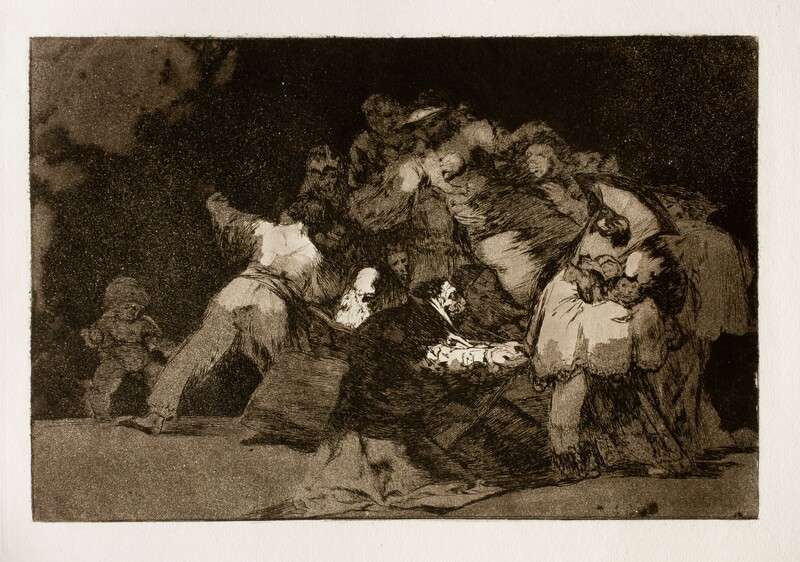- Cronología
- 1815 - 1819
- Dimensiones
- 248 x 359 mm
- Técnica y soporte
- Etching and burnished aquatint
- Reconocimiento de la autoría de Goya
- Documented work
- Ficha: realización/revisión
- 21 Aug 2021 / 05 Jun 2023
- Inventario
- -
See Femenine folly.
The burnished aquatint state proof of the Mead Art Museum, Amherst (Massachusetts, USA) has manuscript General Folly.
A conglomeration of enigmatic figures huddles together in a dense mass. A number of figures can be distinguished amidst the confusion. On the right of the composition, a woman with a feline face and a broad habit holds a group of kittens on a cushion. She seems to be offering them to another figure in clerical garb with the face of a cat, kneeling in front of her, who reaches out her arms to pick up the litter. Behind is a tangle of agitated bodies, including a snouted head and a woman, held by other figures, who has a baby snatched from her arms or, perhaps, pounced upon. At the bottom, a bearded old man with the appearance of a prophet sits on the ground reading a book. Next to him a figure in an attack stance confronts a small figure with a rapier that emerges from the dark background. This mysterious little personage is often identified with Napoleon because of the cap he wears and the weapon he carries. Perhaps Goya wanted to interpret the situation in Spain during the Napoleonic invasion. In front of him stands a heroic boy who represents the resistance of the Spanish people against the occupying forces.
Horror vacui makes it difficult to find meaning. Some see the decadence of Queen Marie-Louise's court in the figure of the kittens because of her predilection for these animals. The gentleness with which she treats them contrasts with the rudeness with which the baby is handled. There is also a criticism of religious practices, as the litter sits on a cushion covered with a Christian skirt and is offered to a priest or clergyman as if it were to be baptised.
The light is arranged on some parts of the figure as if in patches, but the light on the man reading the book os brighter and clearer, as if trying to focus the viewer´s attention on him, perhaps because ir holds the key to the meaning of the print, as his
spirituality and tranquillity contrast with the degeneration around him.
The figures emerge from the dark background of the aquatint, some of which almost merge with it. The space is indeterminate. All that can be made out is a floor on which the figures sit, executed with lines of etching.
The preparatory drawing for the present print, also titled General folly, it has been preserved
-
Etchings by Francosco GoyaJohannesburgoJohannesburgo1974
-
1976
-
Grabados de Goya: colección propiedad de la Biblioteca Nacional, que se conserva en su Gabinete deCasa de la Amistad de MoscúMoscow1979exhibition displayed from January 18th to 31st 1979
-
Goya. Das Zeitalter der Revolucionen. Kunst um 1800 (1980 – 1981)Hamburger KunsthalleHamburg1980cat. 152
-
Goya y el espíritu de la IlustraciónMuseo Nacional del PradoMadrid1988from October 6th to December 18th 1988. Exhibited also at Museum of Fine Arts, Boston, January 18th to March 26th 1989; The Metropolitan Museum of Art, Nueva York, May 9th to July 16th 1989, Madrid curator Manuela B. Mena Marqués, scientific directors Alfonso E. Pérez Sánchez and Eleanor A. Sayre
-
Francisco Goya. Sein leben im spiegel der graphik. Fuendetodos 1746-1828 Bordeaux. 1746-1996Galerie KornfeldBern1996from November 21st 1996 to January 1997
-
Goya. 250 AniversarioMuseo Nacional del PradoMadrid1996consultant editor Juan J. Luna. From March 29th to June 2nd 1996
-
Goya grabadorMuseo del Grabado Español ContemporáneoMarbella1996from March 8th to May 5th 1996
-
Zaragoza1996
-
London1997
-
1999
-
Madrid1999
-
Schlaf der Vernunft. Original radierungen von Francisco de GoyaMunich2000
-
Bilbao2012
-
Goya et la modernitéPinacothèque de ParisParís2013from October 11st 2013 to March 16th 2014cat. 209
-
OxfordBruno Cassirer1964pp. 387-388, cat. 256
-
Vie et ouvre de Francisco de GoyaParísOffice du livre1970p. 325, cat. 1583
-
Catálogo de las estampas de Goya en la Biblioteca NacionalMadridMinisterio de Educación y Cultura, Biblioteca Nacional1996p. 239, cat. 383
-
MadridReal Academia de Bellas Artes de San Fernando y Calcografía Nacional1996p. 109, cat. 29
-
Roma Edizioni de Luca2000pp. 128-129, cat. 41
-
ParísPinacoteca de París2013p. 272
-
Goya. In the Norton Simon MuseumPasadenaNorton Simon Museum2016pp. 204-211

